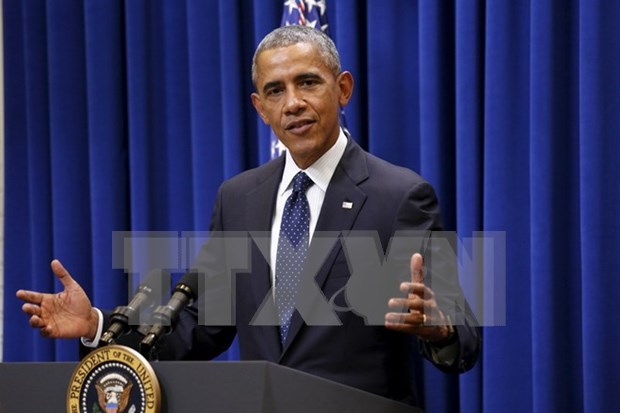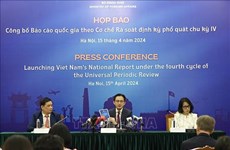TPP members optimistic about economic outlook
The US, Singapore, Peru, Mexico and Australia have raised optimistic voices over the recently completed Trans-Pacific Partnership (TPP) agreement, to which they are members.
 President Obama said the TPP would eliminate or reduce more than 18,000 tariffs imposed on the US by the participating countries (Photo: Reuters/VNA)
President Obama said the TPP would eliminate or reduce more than 18,000 tariffs imposed on the US by the participating countries (Photo: Reuters/VNA)The US, Singapore, Peru, Mexico and Australia have raised optimistic voices over the recently completed Trans-Pacific Partnership (TPP) agreement, to which they are members.
At a meeting with business and agricultural leaders at the Department of Agriculture in Washington D.C. on October 6, US President Barack Obama reiterated benefits that the TPP will bring to the world’s No.1 economy.
He stressed that the deal would eliminate or reduce more than 18,000 tariffs imposed on the US by the participating countries, which means lower prices for international consumers when buying US goods.
Obama’s statement came amidst major challenges in seeking TPP approval from Congress, currently dominated by the Republican Party.
Many congresspersons, however, said the pact could undermine the value and stature of US enterprises and raise the country’s unemployment rate.
In a Facebook post on October 6, Singaporean Prime Minister Lee Hsien Loong wrote that he is “very pleased” that a deal on the TPP was reached after more than five years of negotiations, adding the country’s exporters will have better market access to the other 11 member countries, and investors can expect a more open and level playing field.
“The agreement will open up more opportunities for small- and medium-sized enterprises (SMEs) in TPP countries, and make it easier for them to do business”, he noted.
Singaporean Minister of Trade and Industry Lim Hng Kiang said the deal will transform the region by reducing tariff and non-tariff barriers substantially for both goods and services, encouraging greater investment, and addressing new trade challenges in the modern economy.
The Ministry of Trade and Industry said the TPP will put in place new and updated trade rules to be described as “robust and balanced” to promote fair competition and good governance, encourage innovation and grow the digital economy. This will create more opportunities and allow Singapore-based companies to operate in the region with greater ease and confidence.
Also on October 6, Peruvian President Ollanta Humala said the recently finalised TPP will open a number of opportunities for economic growth and production diversification, helping the member nations on the path to sustainable development.
He also appreciated the role of Peruvian experts in the TPP negotiations that helped protect the interests of traditional exports like seafood, agricultural products and cotton which will earn more chances to access a giant consumer market with combined 800 million people which accounts for 40 percent of the global economy.
President of the Lima Chamber of Commerce Jorge von Wedemeyer said the trade pact will boost Peru’s opening of its market, create more jobs and eliminate poverty.
Silvia Kooker, Foreign Trade Manager of Peru’s National Society of Industries, said with the TPP enforcement, local products could make inroads into markets that the country hasn’t had free trade agreements with like Australia and New Zealand.
The Mexico – US Chamber of Commerce forecasts Mexico’s export turnover will surge by 150 billion USD in the next five years thanks to the TPP, mostly in automobile, electronics, chemical and steel manufacturing.
The chamber believes that the pact will help Mexican firms to expand operations to Australia, Brunei, Malaysia, New Zealand, Singapore and Vietnam, which are potential markets. It will also fuel an inflow of foreign direct investment once taking effect and assist SMEs to take part in new production lines serving new markets.
Meanwhile, Australian analysts shared the view that Australian farmers could introduce more farm products to one of the world’s most giant markets.
Such products of Australia’s strength as beef, milk, butter, cereals, cotton, sugar, fruits, rice, seafood and wine could earn 15 billion AUD from other TPP member countries for Australia a year, surging 33 percent.
The country could save over 4.3 billion AUD as barriers to its farm products are eliminated as regulated by the pact.-VNA












